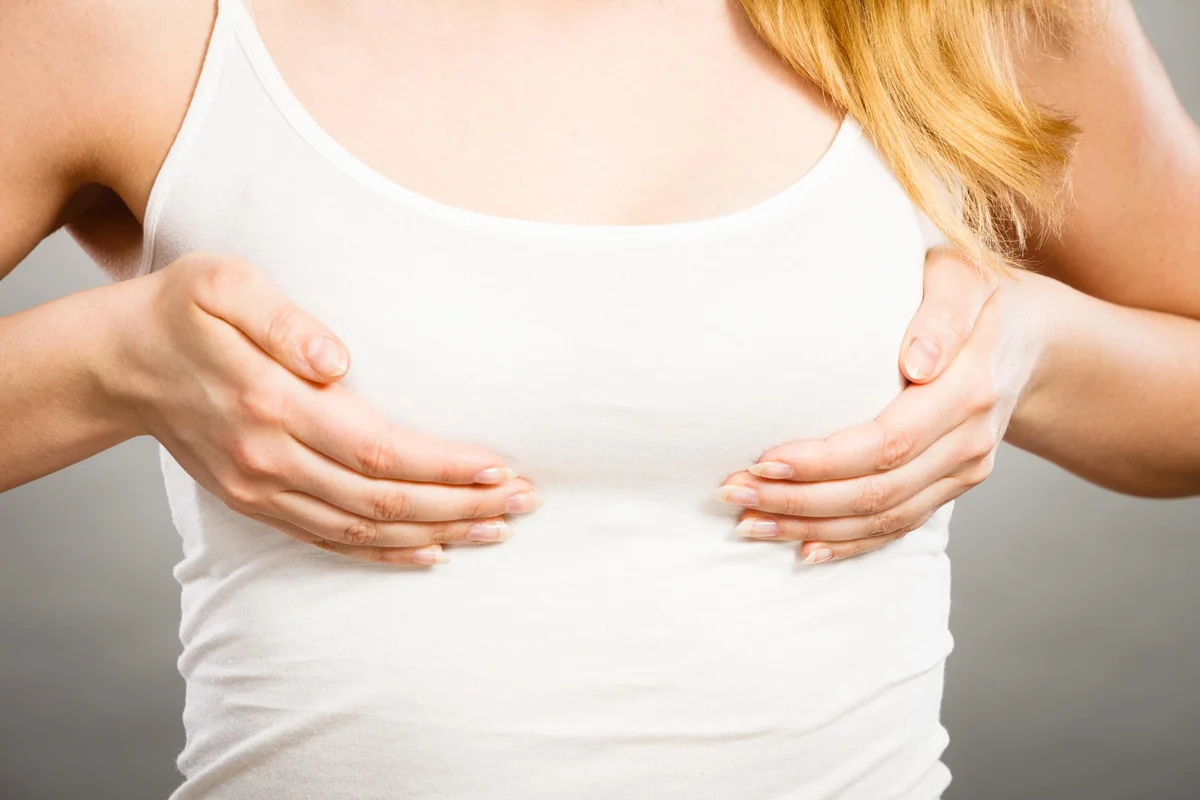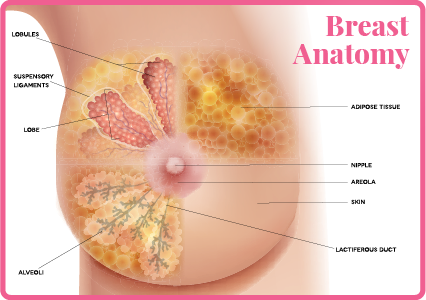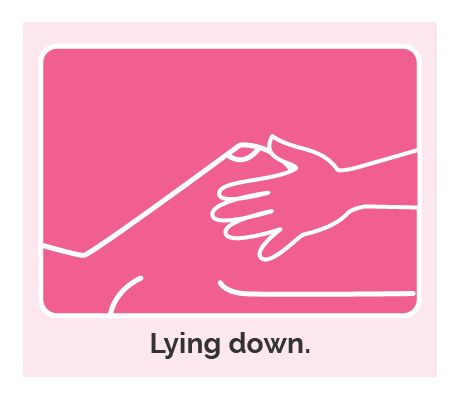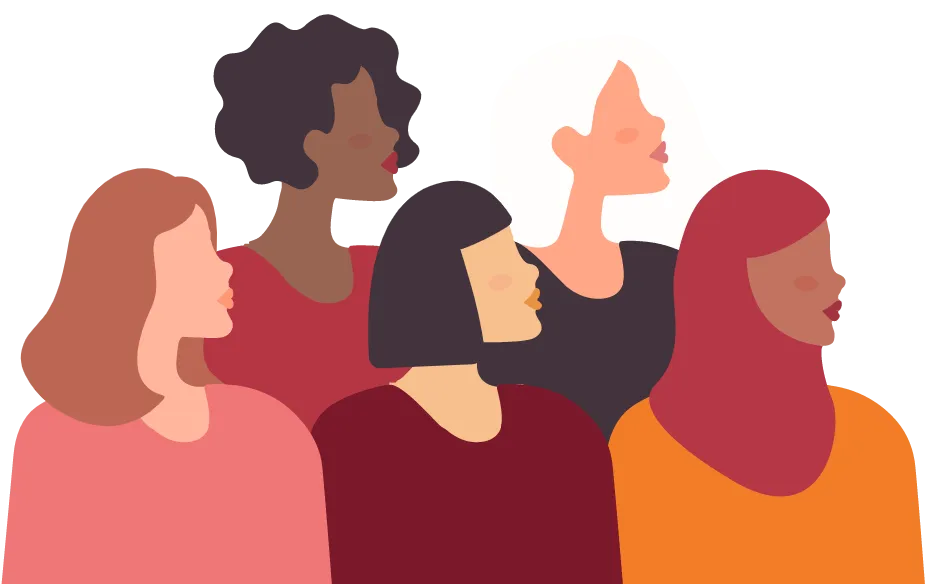
Search powered by AI
Medically Reviewed
The Basics
If you are like most women, you have an intimate relationship with your breasts: you know your cup size, how your breasts look in a bathing suit or form-fitting sweater and when exercising makes your breasts feel sore.
But what about the anatomy of the breast? When should you expect changes to breast size and shape? And how do you know what changes are normal and when to see a health care provider if you have problems? Read on to get the answers.
What are breasts?
Breasts are made up of fatty, fibrous and glandular tissue contained within the front of the chest wall.
- Fatty tissue gives breasts their size and shape.
- Fibrous tissue provides support and structure to the breast.
- Glandular tissue is the part of the breast that produces and carries milk.
Also known as mammary glands, breasts begin to form while the unborn baby is still growing in the mother's uterus. This is why both men and women have nipples and breasts. The difference is that men's breasts do not have the tissue called lobes that produce milk.
The average female breast weighs between seven and 10 ounces and is mostly made up of 12 to 20 lobes that spread out from the nipple like the spokes in a bicycle wheel. These lobes each have one central duct that opens at the nipple, through which milk exits.
Understanding breasts from the inside out
On the inside, women's breasts are made up of the milk-producing glandular tissue, milk ducts that carry breast milk to the nipples and fatty tissue. In fact, the amount of fat determines the size of the breast. The female breast also contains blood vessels, lymph tissue, lymph nodes, a complex system of nerves and connective tissue and ligaments that provide support to the breast and give it its shape.
Although women's breasts vary a lot in size and shape, they all are made of the same parts. On the outside, breasts are covered by skin, which contains the areola (the pink/brown circle that surrounds the nipple); the nipple; and the Montgomery glands (small, raised bumpy glands on the areola that are usually only noticeable during pregnancy and breastfeeding). Montgomery glands produce a substance that cleans, moisturizes and protects the nipple and areola during breastfeeding.
Breasts and hormones go together
The same hormones that trigger your period — estrogen and progesterone — rise and fall with your menstrual cycle, causing your breasts to change in size, shape and feel throughout the month. They are also responsible for the tender, lumpy, swollen and painful breasts you may experience just before your period. When women reach their late 40s and early 50s and approach menopause, they often experience a change in hormone levels that causes the breasts to appear smaller and less full.
Breasts come in many shapes
Each woman's breasts are unique. What determines the shape is where the breast carries the bulk of its tissue on the chest wall and where the nipple is placed. The most common breast shapes are as follows:
- Archetype
The most common shape, the archetype breast is full and round with a small point at the nipple. - Asymmetrical
This is when women's breasts are of two different sizes, which is very common. - Athletic
Athletic breasts are wider with more muscle and less breast tissue. - Bell Shape
Bell-shaped breasts are narrow on top and rounder on the bottom like a bell. - Close Set
These breasts have a small gap between them and are placed close to the center of the chest. - Conical
Shaped like cones instead of being round, this shape is common for smaller breasts. - East West
This is the shape when your nipples point outward, away from the center of your body. - Relaxed
This shape is for breasts with looser breast tissue and nipples that point downward. - Round
Round breasts have the same amount of fullness at the top and the bottom. - Side set
Side-set breasts are spaced far apart with more space between them. - Slender
This shape is when your breasts are narrow and long and the nipples point downward. - Teardrop
The teardrop shape is round where the bottom is a little fuller than the top.
What about breast size?
Breasts can range in size from small to large, depending upon the amount of fat in your breasts — the more fat, the bigger the bust size. It is common and perfectly normal for one breast to be larger than the other, a condition called asymmetry. However, size has nothing to do with the ability to breastfeed and does not affect breast sensitivity or sexual arousal.
When talking about breast size, the reference point is bra size, which is usually based on two measurements:
- Band size – the inches around the chest directly beneath the breasts plus 4 inches if the number is even or 5 inches if the number is odd. For example, if you measure 30 inches beneath the breast, your band size would be 30 + 4 or 34 inches. If you measure 31 inches beneath the breast, your band size would be 31 + 5 or 36 inches.
- Cup size – the measurement of the fullest part of the bust rounded to the nearest inch.
Bra size results from subtracting your band size from your bust measurement. Each inch of difference is one cup size described as a letter starting with A. For example, if your bust measures 34 inches and your band size is 33, the difference is one inch or an A cup. Less than one inch is an AA cup while a 2-inch difference represents a B cup, a 3-inch difference is a C cup, and a 4-inch difference is a D cup. After that, differences in inches are measured as DD/E, DDD/F and above.
What determines breast size and shape?
What can affect breast size and shape? These are the major factors:
- Your genes
According to research, your genes play a key role in determining breast size. In fact, a 2012 study of 16,175 women identified seven genetic markers linked with a woman's bra size. - Your weight
Because size is linked to the amount of fat in the breast, you may see a change in cup size if you gain or lose weight. - Exercise
While not changing your breast size, doing exercises to build up the muscles behind your breast tissue will make your breasts seem slightly perkier and appear a little bigger. - Hormonal changes
As you get close to your period, your body produces progesterone, which causes swelling (and some soreness) in the breasts. Similarly, the estrogen and progesterone in hormonal birth control can increase your breast size somewhat. - Pregnancy
During pregnancy, breasts can grow several cup sizes due to increased production of progesterone. - Age
Many breast changes are linked to the years around menopause when levels of estrogen drop dramatically. As a result, breast tissue becomes less firm, loses its fullness and becomes fattier, which leads to sagging and can produce downward pointing nipples. Other factors leading to breast droop are weight gain, smoking and heredity.
Keeping Breasts Healthy
At every age, you can help keep your breasts healthy by practicing good breast self-care. Here is what you need to know:
1. Practice Breast Awareness
Even though you look at and touch your breasts every day, doing a monthly breast self-exam will help you to be familiar with the look and feel of your breasts so it is easier to notice problems. The National Breast Cancer Foundation explains these ways to do a breast self-exam:
- In the Shower
With the pads/flats of your three middle fingers, check the entire breast and armpit area, pressing down with light, medium and firm pressure. Check both breasts each month, feeling for any lump, thickening, hardened knot or any other breast changes.
- In Front of a Mirror
Look at your breasts with your arms at your sides and then raise your arms high over your head. Look for any changes in the shape and skin, any swelling, or changes in the nipples. Then rest your palms on your hips and press firmly to flex your chest muscles. Check for any changes, particularly on one side.
- Lying Down
When lying down, the breast tissue spreads out evenly along the chest wall. Place a pillow under your right shoulder and your right arm behind your head. Using your left hand, move your fingers around your right breast gently covering the entire breast area and armpit. Then do the same with your right hand on the left breast.
2. Get a Yearly Clinical Breast Exam
Thanks to the Affordable Care Act, women can now get a yearly "well woman" visit that is covered by insurance, which includes a clinical breast exam (CBE). As part of this exam, a trained health provider will carefully feel your breasts, underarm and the area just below the breastbone for any changes, such as a lump. If a CBE is not offered at your check-up, ask your provider about the exam.
3. Follow Screening Recommendations
Most major medical organizations recommend that women should have an annual screening mammogram starting at age 40, and that women at higher risk should speak with their health care providers about additional screening tests. The purpose of this screening is to find breast cancer at its earliest, most treatable stage.
4. Practice Good Skin Care
Skin care for the breasts is just as important as skin care for your face and other areas. Some of the most sensitive skin on the body is on and around the breasts. Breast health organizations recommend daily use of a rich moisturizer on breast skin, applying sun block with a sun protection factor (SPF) of 15 or higher to any areas exposed to the sun, and using moisturizing soaps, cleansing creams or bath or shower gels with added moisturizers instead of drying soaps.
5. Stay Active and Eat Healthy
The American Cancer Society issued guidelines on nutrition and physical activity to help prevent cancer that also apply to keeping breasts healthy. These recommendations include:
- Getting regular physical activity and limiting the amount of high-calorie foods and beverages to help maintain a healthy weight
- Eating more fruits, vegetables and whole grains
- Limiting the amount of processed foods and red meat you eat
- Having no more than one drink of alcohol a day
6. Wear the Right Bra
If breasts are not properly supported, connective tissue in the breast called ligaments will overstretch and sag. Choosing the appropriate bra can help reduce overstretching and sagging.
Especially for women with larger breasts, women's health specialists recommend a bra that shapes the breasts, keeps them pressed against the chest wall and has cups that are positioned properly. It is also important to remember that your bra size can change from year to year so measuring before you go to the store or order online is important to select a bra with the right fit. You should be able to comfortably fasten a bra on the second or third hook; otherwise the bra is too small.
Breast Concerns
It is normal to have concerns about how your breasts look and feel and to worry when you discover a problem, like a breast lump. Read on to get the evidence-based facts about common breast concerns among women so you will know what is normal and when to consult your health care provider.
Different Sized Breasts
A lot of women are uncomfortable having one breast that is a different size or shape than the other but the condition, called asymmetry, is very common. According to a 2018 study, about 50 percent of women have uneven breasts. The study, which compared the left and right breasts of 304 women, found more asymmetry in women with larger breasts and differences in the size and position of the nipple and areola in 50 percent to 60 percent of the women. Breast asymmetry is usually of no medical concern. However, if there are sudden changes in breast size, this could be a sign of cancer and should be checked by a health care provider.
Breast Lumps
It is easy to panic when you find a lump in your breast, but according to the American Cancer Society, most lumps are noncancerous (benign) breast conditions and most women have them. In fact, 80 percent to 85 percent of breast lumps are harmless, especially in women under age 40. Varying in size from smaller than a pea to several inches across, benign breast lumps can be solid, not moveable and feel like a dried bean or can be a moveable lump that is soft and fluid-filled, rolling between your fingers like a grape.
Most harmless breast lumps are directly related to the menstrual cycle, changes in hormones and the fluid buildup that comes with the monthly period, but they can also be related to plugged milk ducts and breast injuries. If you feel a lump, be sure to inform your health care provider to determine if testing is needed.
Fibrocystic Breasts
Half of American women between the ages of 20 and 50 have fibrocystic breasts, a common noncancerous condition that can cause breast pain, breast cysts and lumps in the breast that suddenly appear and go away. Fibrocystic breast changes are believed to be caused by rising and falling levels of hormones, especially estrogen, during the menstrual cycle. The changes are made worse by caffeine, which some studies suggest may contribute to fibrocystic breasts.
Most of the time, no treatment is needed once your health care provider has determined these breast changes are not due to cancer. However, if the lumps are very painful and a biopsy shows no sign of cancer, your health care provider may be able to draw out the cyst through the needle during the biopsy, although the cyst may come back.
Different Life Stages
Your breasts change in a number of ways from puberty through your childbearing years and again around menopause. Here are some of the ways your breasts change at different stages of your life.
Breasts and Puberty
Breast development is often the earliest sign of puberty in girls and begins with the growth of a small bump called a breast bud under the nipple and areola (the darker area of skin around the nipple). When the ovaries start to produce and release estrogen, the fat in the breast tissue starts to collect, causing the breasts to get bigger and rounder over time and the milk-producing glands inside the breasts to grow. In general, breast development begins when girls are between the ages of 8 and 13 years old. A girl's breasts are typically fully developed by age 17 or 18; in some cases, they can grow into her early 20s.
Breasts and the Menstrual Cycle
Once menstruation begins, your breasts go through changes every month linked to levels of the hormones estrogen and progesterone at different points in your menstrual cycle. Early in the cycle, the ovaries start producing estrogen, which stimulates the growth of milk ducts. Then progesterone takes over, enlarging the milk glands in the breasts and often causing swelling, pain and soreness. The week before you get your period is when your breasts are at their fullest. This may cause them to feel lumpy, heavy and tender. These symptoms usually go away when your period begins. At the end of your period, hormones are at their lowest levels, resulting in your breasts being smaller.
Breasts and Pregnancy
Breast changes are one of the first signs of pregnancy. Surging hormone levels and a rapid swelling of the breasts occur as early as one to two weeks after conception, causing soreness down the side of the breasts and nipple tingling or soreness. From the end of the first month of pregnancy, breast development takes off, as estrogen triggers the growth of breast duct cells and progesterone supports the formation and growth of milk-producing cells in the glands of the breasts.
By the fifth or sixth week, the milk-producing cells in the breast become active and are fully able to produce milk. This is the time when breasts start to produce colostrum, the first form of breast milk, and when many women need a larger bra due to the growing size of their breasts. At the same time, the amount of blood flowing to the breasts doubles, which is why many women see veins through their skin.
During the second trimester, pregnant women often notice their nipples and areola becoming larger and darker. Little bumps on the areola called Montgomery's glands begin producing a moisturizing oil that helps protect against soreness and infection once breastfeeding starts. In the third trimester, breasts become even heavier and denser while nipples become larger, darker and more pronounced and may change in shape.
Breasts and Nursing
After giving birth, breast changes continue to occur even if the woman does not breastfeed her infant. The most common post-pregnancy breast changes are sore or leaking breasts and the feeling of very full breasts, referred to as breast engorgement. When women breastfeed, other changes can occur in the breasts, such as tingling sensations when the baby starts to nurse, sore or cracked nipples in the beginning stages of breastfeeding and increased breast size at least for the first months of nursing. Breasts often keep their larger size until breastfeeding is over.
Breasts and Menopause
Many breast changes are a normal part of getting older, especially around the time of perimenopause — the years before you reach menopause when your periods stop. By the time you reach your late 40s and early 50s, your levels of estrogen drop dramatically. The breasts go through a process called "involution" where the glands that produce milk shut down and connective breast tissue becomes dehydrated and loses fullness and firmness. Additionally, your breasts become less dense — meaning there is more fatty tissue than glandular breast tissue, which leads to sagging. As the years go by, you may also notice a wider space between your breasts or downward pointing nipples. It is also possible for your breasts to shrink or to get bigger if you gain weight after menopause.
This resource was created with support from The Allergan Foundation.
References
- PatientInfo. Anatomy of the Breast. Accessible at: https://patient.info/news-and-features/anatomy-of-the-breast
- MedicineNet. Breast Anatomy. Accessible at: https://www.medicinenet.com/breast_anatomy/article.htm#what_should_i_know_about_breast
- Stanford Children's Health. Normal Breast Development and Changes. Accessible at: https://www.stanfordchildrens.org/en/topic/default?id=normal-breast-development-and-changes-85-P00151
- WebMD. Human Anatomy. Picture of the Breasts. Accessible at: https://www.webmd.com/women/picture-of-the-breasts#1
- HealthyWomen. Accessible at: https://www.healthywomen.org/content/ask-expert/1293/my-15-year-old-daughter-has-one-breast-larger-other-she-concerned-they-will
- Verywellfamily.com. Anatomy of the Female Breast for Breastfeeding. Accessible at: https://www.verywellfamily.com/what-are-breasts-431672
- Verywellfamily.com. The Montgomery Glands. Accessible at: https://www.verywellfamily.com/the-montgomery-glands-431671
- HealthyWomen. Your Guide to Breast Health. October 2008. Accessible at: https://roar-assets-auto.rbl.ms/documents/6966/BreastHealthGuide.pdf
- Medical News Today. How do the breasts change with aging and why? July 15, 2019. Accessible at: https://www.medicalnewstoday.com/articles/325749#summary
- Healthline. What Are the Most Common Breast Shapes? Accessible at: https://www.healthline.com/health/breast-shapes
- WedMD. Human Anatomy: Picture of the Breasts. Accessible at: https://www.webmd.com/women/picture-of-the-breasts#1
- Verywellfamily.com. Breastfeeding with Small Breasts. Accessible at: https://www.verywellfamily.com/breastfeeding-with-small-breasts-431770
- Good Housekeeping. How to Measure Your Bra Size and Find the Right Fit for you. Accessible at: https://www.goodhousekeeping.com/clothing/bra-reviews/a29114502/how-to-measure-bra-size/
- Eriksson N, Benton GM, Do CB et al. Genetic variants associated with breast size also influence breast cancer risk. BMC Med Genet 2012, 13: 53
- Brown N, White J, Milligan A, et al. The relationship between breast size and anthropometric characteristics. Am J Hum Biol. 2012 Mar-Apr;24(2):158-64
- Healthline. What's the Average Breast Size? And 9 Other Things to Know. Accessible at: https://www.healthline.com/health/average-breast-size
- Johns Hopkins Medicine. Normal Breast Development and Changes. Accessible at: https://www.hopkinsmedicine.org/health/conditions-and-diseases/normal-breast-development-and-changes
- Verywell Health. How Breasts Change with Age. Accessible at: https://www.verywellhealth.com/how-breasts-change-with-age-2223455
- National Breast Cancer Foundation. Breast Self-Exam. Accessible at: https://www.nationalbreastcancer.org/breast-self-exam
- Susan G. Komen Foundation. Clinical Breast Exam. Accessible at: https://ww5.komen.org/BreastCancer/ClinicalBreastExam.html
- BreastCancer.org. American Society of Breast Surgeons Issues Updated Breast Cancer Screening Guidelines. May 10, 2019. Accessible at: https://www.breastcancer.org/research-news/asbrs-issues-updated-screening-guidelines
- BreastCancer.org. Skin care. Accessible at: https://www.breastcancer.org/tips/hair_skin_nails/skin_care
- American Cancer Society. Summary of the ACS Guidelines on Nutrition and Physical Activity. January/February 2012. https://onlinelibrary.wiley.com/doi/10.3322/caac.20140/fullfor
- Women'sDay. How to Pick the Right Bra. October 2, 2010. Accessible at: https://www.womansday.com/style/fashion/a5285/how-to-pick-the-right-bra-111078/
- Crus NI. Breast Asymmetry in Women Requesting Plastic Surgery of the Breast. PR Health Sci J. 2018 Dec;37(4):230-238.
- Healthline. Breast Asymmetry. Accessible at: https://www.healthline.com/health/breast-asymmetry
- American Cancer Society. Non-cancerous Breast Conditions. Accessible at: https://www.cancer.org/cancer/breast-cancer/non-cancerous-breast-conditions.html
- EveryDayHealth. When to Worry About Breast Lumps. September 2017. Accessible at: https://www.everydayhealth.com/womens-health/when-to-worry-about-breast-lumps.aspx
- Cleveland Clinic. Fibrocystic Breast Changes. Accessible at: https://my.clevelandclinic.org/health/diseases/4185-fibrocystic-breast-changes
- National Cancer Institute. Dense Breasts: Answers to Commonly Asked Questions. September 7, 2018. Accessible at: https://www.cancer.gov/types/breast/breast-changes/dense-breasts
- Philpotts LE. Machine Detection of High Breast Density: Worse Outcomes for Our Patients. Radiology. 2018 Aug;288(2):
353-354 - Healthline. What to Expect When Your Breasts Grow. March 27, 2017. Accessible at:https://www.healthline.com/health/womens-health/do-your-breasts-hurt-when-they-grow
- Johns Hopkins Medicine. Normal Breast Development and Changes. Accessible at: https://www.hopkinsmedicine.org/health/conditions-and-diseases/normal-breast-development-and-changes
- Texas Children's Hospital. Breast Development. Accessible at: https://www.texaschildrens.org/health/breast-development
- Healthline. Symptoms of premenstrual breast swelling and tenderness. Accessible at: https://www.healthline.com/health/breast-premenstrual-tenderness-and-swelling#symptoms
- Health. The 5 Ways Your Boobs Change Throughout the Month. April 12, 2017. Accessible at: https://www.health.com/condition/menstruation/breast-changes-during-menstrual-cycle
- National Institute of Child Health and Human Development. What are some early signs of pregnancy? January 31, 2017. Accessible at: https://www.nichd.nih.gov/health/topics/pregnancy/conditioninfo/signs
- Healthline Parenthood. Breast Changes in Pregnancy: What to Expect. January 9, 2017. Accessible at: https://www.healthline.com/health/pregnancy/pregnant-breast
- Geddes DT. Ultrasound imaging of the lactating breast: methodology and application. Int Breastfeed J. 2009;4(1):4.
- Doucet S et al. The secretion of areolar (Montgomery's) glands from lactating women elicits selective, unconditional responses in neonates. PLoS One. 2009;4(10):e7579.
- Medical News Today. How do breasts change during and after pregnancy? June 28, 2019. Accessible at: https://www.medicalnewstoday.com/articles/325602
- Healthline. Aging Changes in the Breast. February 27, 2019. Accessible at: https://www.healthline.com/health/aging-changes-in-the-breast
- Ghosh K, et al. Association Between Mammographic Density and Age-Related Lobular Involution of the Breast. J Clin Oncol. 2010 May 1; 28(13): 2207–2212
- Mayo Clinic. Dense Breast Tissue: What It Means to Have Dense Breasts. February 18, 2020. Accessible at: https://www.mayoclinic.org/tests-procedures/mammogram/in-depth/dense-breast-tissue/art-20123968
- Medical News Today. How does aging affect the breasts? July 15, 2019. Accessible at: https://www.medicalnewstoday.com/articles/325749
- den Tonkelaar I, et al. Increase in breast size after menopause: prevalence and determinants. Maturitas. 2004 May 28;48(1):51-7.
HealthyWomen content is for informational purposes only. Please consult your healthcare provider for medical advice, diagnosis or treatment.
Related Articles
Haciendo que el acceso a la atención para el cáncer de mama sea más fácil
Centros satelitales de atención mamaria, mamografías móviles y biopsias con resultados para el mismo día están haciendo que las mujeres puedan obtener atención mamaria más fácilmente
01 May 2023
Your HealthYour First Mammogram: A Step-by-Step Guide
Not sure what to expect during your first mammogram? Watch this video to find out.
08 Nov 2022
VideosBreast Health Glossary of Terms
Understanding your breasts and how to keep them healthy requires knowing the language.
04 Oct 2022
Conditions & Treatments














